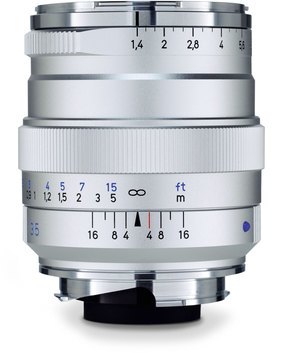
Carl Zeiss ZM lenses is an amazing phenomenon is photography: despite their excellent quality and ergonomics, most Leica M shooters do not even know about them. The main reason for their relatively low popularity, besides snobbish attitude of “those with the best glass in the world”, is that at any focal length Leica optics surpassed Zeiss ZM lenses in speed. That is until now…
I’ve been using Zeiss ZM wide-angle lenses since 2008 and always wished for them to be at least one stop faster. So, the news about the new Distagon 1.4/35 sounded very interesting, and I waited impatiently for Carl Zeiss to send me a sample for review.
My first impression, upon opening the box, was “OMG, why is it so huge?”. Indeed, most ZM lenses are physically shorter and take 46mm filters or smaller. The new lens has a 49mm filter thread and a hefty barrel. However, mounted on an M9 body it balanced perfectly and was convenient to hold.Focusing knob is small and not too convenient to hold on to. I ended up using it as a reference point: the lens has a 90-degree focus throw, and by feeling the knob it is easy to figure out the distance a focusing ring is set to without taking an eye from a viewfinder. May sound like no big deal, but it saves me a second eliminating guess-work as to which direction should I be twisting.Precision is a word that comes to mind when it comes to describing mechanical features of the lens. Focusing is smooth and clean. 90-degree throw perfectly suits the focal length. Aperture blades form a nearly perfect circle. An aperture ring is graduated in 1/3 stop increments, which is a trademark for ZM lenses. Not sure of how useful this feature is, given impressive photographic latitude of Leica DNG files, but it surely feels great.To sum up, I would rate ergonomics and mechanical built as outstanding. The only objection that I have is against an intricate double-spring design of a front cap, which is also common for all ZM lenses. For some reason, it never fits snug on the first attempt. It takes several seconds to find proper alignment.
To simply call optical quality of this lens outstanding would be an understatement. All incarnations of Leica Summilux 1.4/35 ASPH, as great as they are, even the FLE version, are in trouble for the following reasons:
Color and contrast
- This lens is contrasty, even when shooting against the light, which makes it great for B&W photography.
- High microcontrast makes images look three-dimensional even when lighting is relatively flat.
- Flare is very well controlled. A lens hood was not included, but I have yet to encounter a situation where it would be indispensable.
- Even with high contrast, highlights do not get blown out easily. Details are visible even in areas overexposed up to 4 stops on Leica M9.
- Colors are vivid, yet not aggressive. Skin tones are smooth and natural, which makes it a great choice for people photography and especially environmental portraiture.

- There is no focus shift. None. Well, maybe it is, but I could not detect it in practical applications, as it is fully compensated by change in DOF.
- Slight overexposure reveals beautiful ever so subtle glow, which is reminiscent of Summilux 1.4/35 pre-ASPH, but less intrusive. It helps the lens conceal skin imperfections while maintaining high enough definition of such details as eyelashes and corneal patterns on a face occupying just 1/10 of a frame area. The glow is probably due to a tiny level of under-correction of spherical aberration meant to prevent focus shift (see below).
- Point light sources and specular highlights are rendered correctly, even when wide open. The lens proved to be an excellent choice for a candlelit scene.
- Chromatic aberrations are also well controlled, both lateral and longitudinal. I managed to get some of the latter on a backlit out-of-focus edge with more than six stops of contrast. I do not know a lens, which would not do that at f/1.4.
- While stopped down, the lens is very sharp, yet not “clinical”, which makes it well-suitable for environmental portraiture, etc.
- This lens is sharp corner-to-corner at any aperture. It gets only a tad softer at f/16, which is of no surprise, as diffraction is not something that can be easily eliminated.
- At f/1.4 light falloff is present, yet it is so low that sometimes I had to add some vignetting in Lightroom. Not only it is low, there is no visible color change towards sides and corners both with Leica M9 and Sony a7R, which is notoriously known for producing a colorful vignette with third-party wide-angle lenses. While some vignette is usually welcome in fine art photography, technical applications demand color and tonal fidelity. Such little falloff is great news because it is much harder to get rid of dark corners than to add a vignette, especially when tonal change is accompanied by color shifts.
To sum up, Carl Zeiss Distagon 1.4/35 ZM is a formidable competitor to any 35mm rangefinder lens from any manufacturer. Its color fidelity, sharpness and exceptional control of distortions and aberrations amounts to outstanding image quality.
Now, the most difficult part. It renders differently from its competitors, somewhat cleaner perhaps. I cannot say, however, that this is an advantage, neither it is a shortcoming. Let’s put it this way: if I were compelled to describe Leica Summilux 1.4/35 pre-ASPH with just one word, it would be “capricious”. For Carl Zeiss Distagon 1/4/35 ZM it is “immaculate”.



You must be logged in to post a comment.